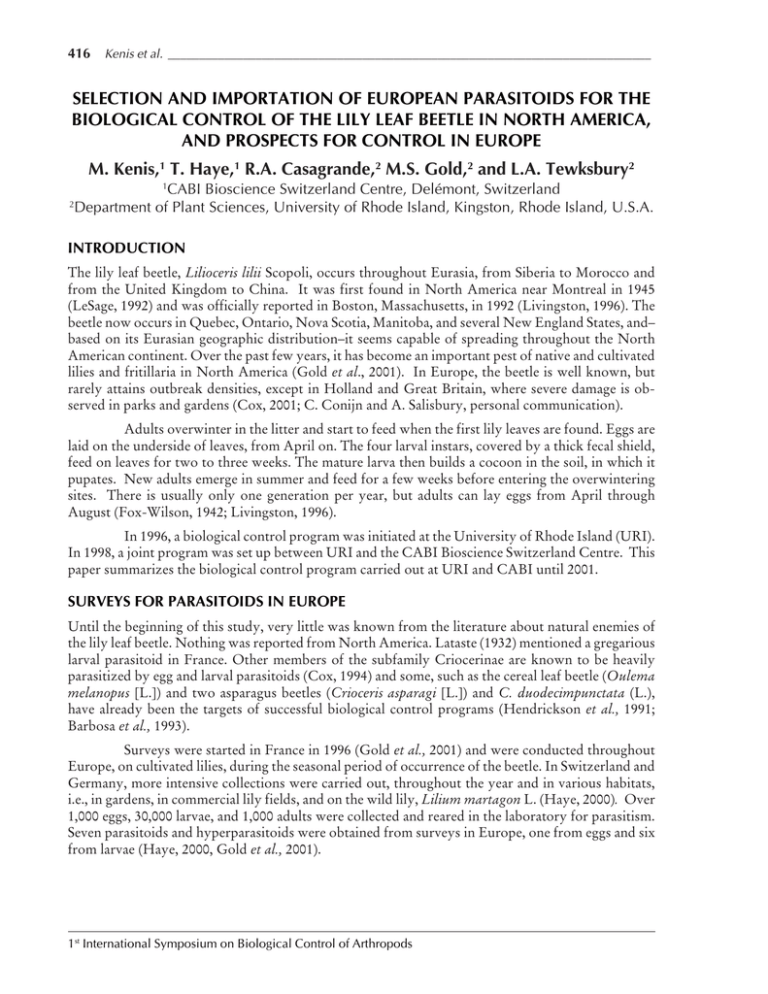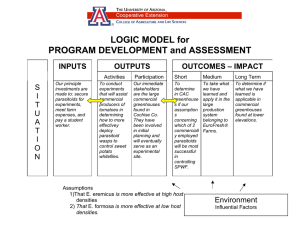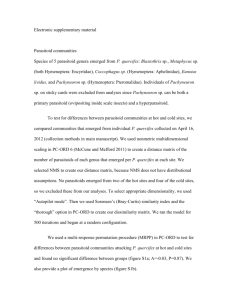SELECTION AND IMPORTATION OF EUROPEAN PARASITOIDS FOR THE
advertisement

416 Kenis et al. _____________________________________________________________________________ SELECTION AND IMPORTATION OF EUROPEAN PARASITOIDS FOR THE BIOLOGICAL CONTROL OF THE LILY LEAF BEETLE IN NORTH AMERICA, AND PROSPECTS FOR CONTROL IN EUROPE M. Kenis,1 T. Haye,1 R.A. Casagrande,2 M.S. Gold,2 and L.A. Tewksbury2 1 2 CABI Bioscience Switzerland Centre, Delémont, Switzerland Department of Plant Sciences, University of Rhode Island, Kingston, Rhode Island, U.S.A. INTRODUCTION The lily leaf beetle, Lilioceris lilii Scopoli, occurs throughout Eurasia, from Siberia to Morocco and from the United Kingdom to China. It was first found in North America near Montreal in 1945 (LeSage, 1992) and was officially reported in Boston, Massachusetts, in 1992 (Livingston, 1996). The beetle now occurs in Quebec, Ontario, Nova Scotia, Manitoba, and several New England States, and– based on its Eurasian geographic distribution–it seems capable of spreading throughout the North American continent. Over the past few years, it has become an important pest of native and cultivated lilies and fritillaria in North America (Gold et al., 2001). In Europe, the beetle is well known, but rarely attains outbreak densities, except in Holland and Great Britain, where severe damage is observed in parks and gardens (Cox, 2001; C. Conijn and A. Salisbury, personal communication). Adults overwinter in the litter and start to feed when the first lily leaves are found. Eggs are laid on the underside of leaves, from April on. The four larval instars, covered by a thick fecal shield, feed on leaves for two to three weeks. The mature larva then builds a cocoon in the soil, in which it pupates. New adults emerge in summer and feed for a few weeks before entering the overwintering sites. There is usually only one generation per year, but adults can lay eggs from April through August (Fox-Wilson, 1942; Livingston, 1996). In 1996, a biological control program was initiated at the University of Rhode Island (URI). In 1998, a joint program was set up between URI and the CABI Bioscience Switzerland Centre. This paper summarizes the biological control program carried out at URI and CABI until 2001. SURVEYS FOR PARASITOIDS IN EUROPE Until the beginning of this study, very little was known from the literature about natural enemies of the lily leaf beetle. Nothing was reported from North America. Lataste (1932) mentioned a gregarious larval parasitoid in France. Other members of the subfamily Criocerinae are known to be heavily parasitized by egg and larval parasitoids (Cox, 1994) and some, such as the cereal leaf beetle (Oulema melanopus [L.]) and two asparagus beetles (Crioceris asparagi [L.]) and C. duodecimpunctata (L.), have already been the targets of successful biological control programs (Hendrickson et al., 1991; Barbosa et al., 1993). Surveys were started in France in 1996 (Gold et al., 2001) and were conducted throughout Europe, on cultivated lilies, during the seasonal period of occurrence of the beetle. In Switzerland and Germany, more intensive collections were carried out, throughout the year and in various habitats, i.e., in gardens, in commercial lily fields, and on the wild lily, Lilium martagon L. (Haye, 2000). Over 1,000 eggs, 30,000 larvae, and 1,000 adults were collected and reared in the laboratory for parasitism. Seven parasitoids and hyperparasitoids were obtained from surveys in Europe, one from eggs and six from larvae (Haye, 2000, Gold et al., 2001). 1st International Symposium on Biological Control of Arthropods ______________________ Selection and importation of European parasitoids of the lily leaf beetle 417 BIOLOGY, ECOLOGY, AND DISTRIBUTION OF EUROPEAN PARASITOIDS Anaphes sp. (Hym.: Mymaridae) was reared from lily leaf beetle eggs, but collected exclusively from forested areas. It is a gregarious species with up to seven individuals emerging per host egg. Anaphes sp. is an undescribed, multivoltine species which overwinters in an unknown host species. It is not suitable for classical biological control because it is not specific and needs alternate hosts to complete its development. Tetrastichus setifer Thomson (Hym.: Eulophidae) is a gregarious parasitoid that attacks all four larval stages and kills its hosts in their cocoons in the soil. It is strictly univoltine and overwinters in the larval stage in the host cocoon. Up to 21 adults emerge in spring from each L. lilii host larva. The emergence is protracted, with individuals from the same brood emerging over several weeks. It was the most widespread species encountered, occurring in all regions investigated, from Bulgaria to the United Kingdom and from northern Germany to Italy. Diaparsis jucunda Holmgren (Hym.: Ichneumonidae) is a solitary, univoltine, larval parasitoid, attacking all larval stages and killing the prepupa in the host cocoon, and then overwintering as a larva. It is the dominant parasitoid in central and southern Europe (e.g., Switzerland, Austria, and Italy), especially on wild lilies. In contrast, it is nearly absent from western and northern Europe. Lemophagus errabundus Gravenhorst (Hym.: Ichneumonidae) is also a solitary, univoltine, larval parasitoid killing the beetle in the pre-pupal stage. It overwinters as a teneral adult in the host cocoon. It replaces D. jucunda as a dominant parasitoid in western and northern Europe (United Kingdom, The Netherlands, western France, and northern Germany), but it is rare elsewhere. Lemophagus pulcher (Szepligeti) is similar to the previous species, except that it is partly bivoltine. About 30-40% of the individuals emerge for a second generation, both in laboratory and outdoor rearing. It is a very widespread species, occurring in nearly all regions investigated (except the United Kingdom), but dominates only in Bulgaria. Both Lemophagus spp. are parasitized by an ichneumonid hyperparasitoid, Mesochorus lilioceriphilus Schwenke. Meigenia sp. (Dipt.: Tachinidae) was occasionally reared from lily leaf beetle larvae collected in Germany, France, Switzerland, and Bulgaria. The specimens from France were identified as Meigenia simplex Tschorsnig and Herting. Parasitism rates were usually very high. In Switzerland in 1999, total parasitism in the last instar averaged about 60% in cultivated lily fields, 75% in gardens, and 90% on the wild lily L. martagon. At natural sites, the parasitoid guild was strongly dominated by D. jucunda, which accounted for over 90% of the parasitoids reared. The same species also dominated in gardens and commercial fields in the first part of the season, but was later replaced by T. setifer and L. pulcher, the former due to its protracted emergence period, and the latter because of a partial second generation (Haye, 2000). HOST SPECIFICITY Host specificity of the four main larval parasitoids was assessed using two methods. First, data were gathered from the literature and our own collections on the parasitoid complexes of closely related Criocerinae species in Europe. Second, laboratory screening tests were run on potential non-target species (Gold, Haye and Kenis, unpub.). None of the four main larval parasitoids had been recorded from any other host in Europe before this study, with the exception of L. errabundus, reported from Lilioceris merdigera (L.) in France (Elliott and Morley, 1911). The well studied cereal leaf beetle (O. melanopus) and the aspara- 1st International Symposium on Biological Control of Arthropods 418 Kenis et al. _____________________________________________________________________________ gus beetles (C. asparagi and C. duodecimpunctata) are three Criocerinae with similar biologies to that of the lily leaf beetle that also have very similar parasitoid complexes. These complexes, however, are made up of different species in the genera Tetrastichus, Diaparsis, and Lemophagus (Dysart et al., 1973; Hendrickson et al., 1991). Two other species of Lilioceris occur in central Europe: L. merdigera, a common species feeding on other Liliaceae of the genera Polygonatum, Convallaria, and Allium; and the rare Lilioceris tibialis (Villa) found on Lilium spp. at high altitudes in the Alps. Since almost nothing was known of the parasitoids of these two species, collections were made in regions where the three species occurred sympatrically, and their respective parasitoid complexes were compared. Studies showed that all three beetles were attacked by the same four parasitoids, but proportions varied dramatically. Parasitism in wild populations of L. lilii was strongly dominated by D. jucunda, which was rare on L. tibialis and nearly absent from L. merdigera. This latter species was mainly parasitized by L. pulcher, whereas parasitism in L. tibialis was dominated by T. setifer, with the two species of Lemophagus being occasionally abundant. No-choice screening tests were run with the four parasitoids under study on nine other Chrysomelidae (including the two Lilioceris spp., four other Criocerinae, two Chrysomelinae, and one Gallerucinae) and three species of Coccinellidae. The four parasitoids attacked and developed in L. merdigera and L. tibialis but showed no interest in the other species offered to them. In contrast, L. pulcher parasitized successfully two other criocerine species, C. asparagi and Lema trilineata Olivier. CONCLUSIONS–CLASSICAL BIOLOGICAL CONTROL PROGRAM Parasitism of the lily leaf beetle is very high in Europe, and damage is usually much lower than in North America, suggesting potential for biological control. Four larval parasitoids can be locally, or temporally, abundant. Three of them seem specific at the genus level. Since no species in the genus Lilioceris are native to North America, nor are there any other North American species of Criocerinae that feed on the genera Lilium or Fritillaria, these three parasitoid species are all suitable for introduction in North America. A combination of at least two species is probably desirable because each of them seems to have different ecological or climatic preferences. Furthermore, the three parasitoids cover different periods in the season, D. jucunda and L. errabundus occurring earlier than T. setifer, which emerges later but remains longer in the field and parasitizes late-occurring larvae in summer. Over 3,000 females of T. setifer were released in the summer of 2001 in Massachusetts. Investigations are presently being completed to allow the selection of an additional species for introduction. POTENTIAL FOR OTHER BIOLOGICAL CONTROL STRATEGIES Other biological control strategies for lily leaf beetle are presently being considered, in particular for countries in Europe that suffer from lily leaf beetle damage, such as the United Kingdom and The Netherlands. Plowing and removal of bulbs before winter has a detrimental effect on the survival of parasitoids, which overwinter in host cocoons at the bottom of the stems. Covering the soil with mulch in autumn instead of removing bulbs would help conserve parasitoids in gardens. Augmentative biological control might also be considered, using the egg parasitoid Anaphes sp., in particular in commercial lily fields. Anaphes sp. is usually present only in forests, most likely because its alternate hosts are forest species. However, since this parasitoid is multivoltine and has a very short life cycle, it could be released in commercial fields at the beginning of the season and maintain itself until late summer. For this to be possible, however, proper rearing and production techniques would have to be developed. 1st International Symposium on Biological Control of Arthropods ______________________ Selection and importation of European parasitoids of the lily leaf beetle 419 ACKNOWLEDGMENTS We thank all friends and colleagues who helped us collect the lily leaf beetle in Europe, with a special thanks to Gisela Haye and Rumen Tomov for their extensive work in Germany and Bulgaria, as well as Andy Salisbury for providing us with data from United Kingdom and for reviewing the manuscript. We also acknowledge Cor Conijn for providing us with thousands of lily bulbs for laboratory rearing. Parasitoids were determined by Klaus Horstmann, John Huber, John LaSalle, Wolfgang Schwenke, and Hans-Peter Tschorsnig. The project was financed by the University of Rhode Island, White Flower Farm, the USDA Northeast Region IPM Program, and the North American Lily Society. REFERENCES Barbosa, P., S. M. Braxton, and A. E. Segarra-Carmona. 1993. A history of biological control in Maryland. Biological Control 4: 185-243. Cox, M. L. 1994. The Hymenoptera and Diptera parasitoids of Chrysomelidae, pp. 419-467. In Jolivet, P. H., M. L. Cox, and E. Petitpierre (eds.). Novel Aspects of the Biology of Chrysomelidae. Kluwer Academic Publishers, Dordrecht, The Netherlands. Cox, M. L. 2001. The status of the lily beetle Lilioceris lilii (Scopoli, 1763) in Britain (Chrysomelidae: Criocerinae). The Coleopterist 10: 5-20. Dysart, R. J., H. L. Maltby, and M. H. Brunson. 1973. Larval parasites of Oulema melanopus in Europe and their colonization in the United States. Entomophaga 18:133-167. Elliott, E. A. and C. Morley. 1911. On the Hymenopterous parasites of Coleoptera. First Supplement. Transactions of the Entomological Society of London, pp. 452-497. Fox-Wilson, G. 1942. The lily beetle, Crioceris lilii (Scop.). Journal of the Royal Horticultural Society 67: 165-168. Gold, M. S., R. A. Casagrande, L. A. Tewksbury, S. B. Livingston, and M. Kenis. 2001. European parasitoids of Lilioceris lilii (Coleoptera: Chrysomelidae). The Canadian Entomologist 133: 671674. Haye, T. 2000. Oekologische Studien zum Parasitoidencomplex von Lilioceris lilii /Scop.) (Coleoptera: Chrysomelidae) an ausgewählten mitteleuropäischen Standorten. Diploma thesis, University of Kiel, Kiel, Germany. Hendrickson, R. M., Jr., F. Gruber, G. Mailloux, and J. J. Drea. 1991. Parasite colonizations against Crioceris asparagi (L.) and C. duodecimpunctata (L.) (Coleoptera: chrysomelidae) in North America from 1983 to 1988. Proceedings of the Entomological Society of Washington 93: 67-69. Lataste, F. 1932. Addition à ma note du 10 mars 1931 sur le criocère du lys. Bulletin de la Société de Zoologie de France 57: 36-39. LeSage, L. 1992. The lily beetle, Lilioceris lilii (Scopoli) in Canada (Coleoptera: Chrysomelidae). La Revue Canadienne des Insectes Nuisibles aux Cultures 70: 88-96. Livingston, S. S. 1996. Biology, control and host range of Lilioceris lilii: a new ornamental pest in the USA. MS thesis, University of Rhode Island, Kingston, Rhode Island, U.S.A. 1st International Symposium on Biological Control of Arthropods




